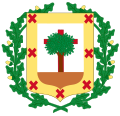This article needs additional citations for verification .(July 2024) |
This article is missing information about descriptions of the flags.(July 2022) |
This is a list of flags of provinces of Spain . The flags are listed per autonomous community. The list also discusses coat of arms as most flags feature them.
Contents
- Andalusia
- Aragon
- Asturias
- Balearic Islands
- Basque Country
- Canary Islands
- Cantabria
- Castile and León
- Castilla-La Mancha
- Catalonia
- Extremadura
- Galicia
- La Rioja
- Community of Madrid
- Region of Murcia
- Navarre
- Valencian Community
- Historical
- References
- See also
In addition to the provinces which have no official flag (A Coruña, Zamora and the whole Valencian Community: Alicante, Castellón, Valencia), which sometimes use erroneously the capital town flag, or with the variants sometimes used by official institutions (like Diputación Provincial, for example in the case of Lugo) there might be some other confusion and controversies with background colour of the ones of Gipuzkoa (red Saint Andrew cross on blue field instead of white) and Badajoz (blue instead of burgundy), not for the coat of arms.

















































